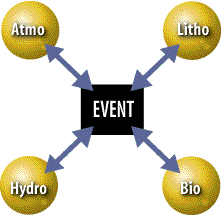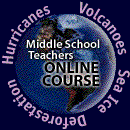![]()
![]()
![]()
Assessment
Overview: Sphere Study Assignment & Rubric
Weeks
4, 7, 10, and 13
Goal: Become experts in the relationship of one sphere to an Earth event (deforestation, volcanic eruption, ice shelf disintegration, hurricane).
Note: Refer to Group & Team Formation to find out which sphere you should be studying this week.
|
Assignment
(by midnight Sunday)
1. List your questions, theories, and prior knowledge about the sphere you are studying this week. Refer to the Journal Rubric. Posting instructions for steps 2-4
2. Use the Sphere Study Rubric as a guide and work with your group to:
To address the last two bullets, you may need to make a list of as many questions as you can about the sphere and the event, and do research to answer your questions. Refer to the Week 3: An Example of an ESS Analysis reading if you would like to review E > S and S > E interactions. 3. Think about some possible interactions that could occur between your sphere and the other spheres while you are still with your Sphere Group. 4. Prepare a summary of the most important information concerning your group's sphere and post it in Event Space so that you can share it with your Event Team next week. Posting instructions for step 5
5. Reflect on what and how you have learned. Refer to the Journal Rubric. |

Rubric
Your Sphere Group analysis needs to include:
- List the effects of the Event on the Sphere (E > S) with reasoning and support.
- List of the effects of the Sphere on the Event (S > E) with reasoning and support.
You should write as many interactions as you can that include accuracy, depth of reasoning, and quality of support. Use the rubric below to evaluate and improve your analysis as your work will be graded based on the rubric being applied to each E > S and S > E interaction you list. Each interaction that earns a 3 or 4 rating will be worth one point toward the maximum four points you can earn for this assignment.
| Rubric Criteria: Accuracy | |||
| 4
Rating: Powerful, comprehensive, statements. |
3
Rating: Comprehensive statements. |
2
Rating: Clear, complete statements. |
1
Rating: Simple statements that are partially correct. |
| Rubric Criteria: Depth of Reasoning | |||
| 4
Rating: Reasoning completely supports the hypothesized effect or interaction. |
3
Rating: Uses scientific reasoning, concepts, and processes to explain the interaction. |
2
Rating: Includes science concepts and processes in the reasons for the effect and the interaction. |
1
Rating: Explains at least two reasons for the effect or interaction. |
| Rubric Criteria: Quality of Support | |||
| 4
Rating: Compelling use of existing research and knowledge. |
3
Rating: Uses logical support that is convincing using data and authority. |
2
Rating: Uses reliable data from multiple sources. |
1
Rating: Uses relevant and respected authorities. |
![]()
Welcome
...Earth's
Spheres ...Earth
System Science ...
Use of Technology ...Science
as Inquiry ...Participation
...
Group & Team Formation ...Assessment
Overview...
Course Sections
...
Home ...Guide ...Outline ...Classroom
...
![]()

|
Sphere Study Assignment & Rubric Event Study Assignment & Rubric Classroom Application Assignment & Rubric |
Maintained by ESSC Team
Last Updated September 05, 2000
Privacy Statement and Copyright© 1997-2000 by Wheeling Jesuit University/NASA Classroom of the Future™. All rights reserved.
